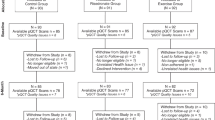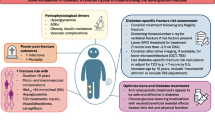Abstract
Summary
In two large German population-based cohorts, we showed positive associations between serum thyrotropin (TSH) concentrations and the Fracture Risk Assessment score (FRAX) in men and positive associations between TSH concentrations and bone turnover markers in women.
Introduction
The role of thyroid hormones on bone stiffness and turnover is poorly defined. Existing studies are confounded by differences in design and small sample size. We assessed the association between TSH serum concentrations and bone stiffness and turnover in the SHIP cohorts, which are two population-based cohorts from a region in Northern Germany comprising 2654 men and women and 3261 men and women, respectively.
Methods
We calculated the bone stiffness index using quantitative ultrasound (QUS) at the calcaneus, employed FRAX score for assessment of major osteoporotic fractures, and measured bone turnover markers, N-terminal propeptide of type I procollagen (P1NP), bone-specific alkaline phosphatase (BAP), osteocalcin, and type I collagen cross-linked C-telopeptide (CTX) in all subjects and sclerostin in a representative subgroup.
Results
There was no association between TSH concentrations and the stiffness index in both genders. In men, TSH correlated positively with the FRAX score both over the whole TSH range (p < 0.01) and within the reference TSH range (p < 0.01). There were positive associations between TSH concentrations and P1NP, BAP, osteocalcin, and CTX (p < 0.01) in women but not in men. There was no significant association between TSH and sclerostin levels.
Conclusions
TSH serum concentrations are associated with gender-specific changes in bone turnover and stiffness.



Similar content being viewed by others
References
Gogakos AI, Duncan Bassett JH, Williams GR (2010) Thyroid and bone. Arch Biochem Biophys 503:129–136
Vestergaard P, Rejnmark L, Mosekilde L (2005) Influence of hyper-and hypothyroidism, and the effects of treatment with antithyroid drugs and levothyroxine on fracture risk. Calcif Tissue Int 77:139–144
Abrahamsen B, Jørgensen HL, Laulund AS, Nybo M, Brix TH, Hegedüs L (2014) Low serum thyrotropin level and duration of suppression as a predictor of major osteoporotic fractures-the OPENTHYRO register cohort. J Bone Miner Res 29:2040–2050
Vestergaard P, Mosekilde L (2003) Hyperthyroidism, bone mineral and fracture risk: a meta-analysis. Thyroid 12:411–419
Murphy E, Glüer CC, Reid DM, Felsenberg D, Roux C, Eastell R, Williams GR (2010) Thyroid function within the upper normal range is associated with reduced bone mineral density and an increased risk of nonvertebral fractures in healthy euthyroid postmenopausal women. J Clin Endocrinol Metab 95:3171–3181
Svare A, Nilsen TI, Bjøro T, Forsmo S, Schei B, Langhammer A (2009) Hyperthyroid levels of TSH correlate with low bone mineral density: the HUNT 2 study. Eur J Endocrinol 161:779–786
Cauley JA, Blackwell T, Zmuda JM, Fullman RL, Ensrud KE, Stone KL, Barrett-Connor E, Orwoll ES, Osteoporotic Fractures in Men Study (2010) Correlates of trabecular and cortical volumetric bone mineral density at the femoral neck and lumbar spine: the osteoporotic fractures in men study (MrOS). J Bone Miner Res 25:1958–1971
Kim KC, Lee YK, Lee YJ, Ha YC, Koo KH (2014) Bone health and clinical results after hip fracture surgery in patients with subclinical hypothyroidism. J Bone Metabol 21:213–216
Jódar E, Martínez-Díaz-Guerra G, Azriel S, Hawkins F (2001) Bone mineral density in male patients with L-thyroxine suppressive therapy and Graves disease. Calcif Tissue Int 69:84–87
Hans D, Schott AM, Meunier PJ (1993) Ultrasonic assessment of bone: a review. Eur J Med 2:157–163
Raum K, Grimal Q, Varga P, Barkmann R, Glüer CC, Laugier P (2014) Ultrasound to assess bone quality. Curr Osteoporos Rep 12:154–162
Greenspan SL, Bouxsein ML, Melton ME, Kolodny AH, Clair JH, Delucca PT, Stek M Jr, Faulkner KG, Orwoll ES (1997) Precision and discriminatory ability of calcaneal bone assessment technologies. J Bone Miner Res 12:1303–1313
Moayyeri A, Adams JE, Adler RA, Krieg MA, Hans D, Compston J, Lewiecki EM (2012) Quantitative ultrasound of the heel and fracture risk assessment: an updated meta-analysis. Osteoporos Int 23:143–153
Gómez Acotto C, Schott AM, Hans D, Niepomniszcze H, Mautalen CA, Meunier PJ (1998) Hyperthyroidism influences ultrasound bone measurement on the Os calcis. Osteoporos Int 8:455–459
Hadji P, Hars O, Sturm G, Bauer T, Emons G, Schulz KD (2000) The effect of long-term, non-suppressive levothyroxine treatment on quantitative ultrasonometry of bone in women. Eur J Endocrinol 142:445–450
Rosen CJ, Adler RA (1992) Longitudinal changes in lumbar bone density among thyrotoxic patients after attainment of euthyroidism. J Clin Endocrinol Metab 75:1531–1534
Kanis JA, Johnell O, Oden A, Johansson H, McCloskey E (2008) FRAX and the assessment of fracture probability in men and women from the UK. Osteoporos Int 19:385–397
Polovina S, Popovic V, Duntas L, Milic N, Micic D (2013) Frax score calculations in postmenopausal women with subclinical hypothyroidism. Hormones (Athens) 12:439–448
Al-Shoumer KA, Vasanthy BA, Al-Zaid MM (2006) Effects of treatment of hyperthyroidism on glucose homeostasis, insulin secretion, and markers of bone turnover. Endocr Pract 12:121–130
Schneider R, Schneider M, Reiners C, Schneider P (2012) Effects of levothyroxine on bone mineral density, muscle force, and bone turnover markers: a cohort study. J Clin Endocrinol Metab 97:3926–3934
Krishnan V, Bryant HU, MacDougald OA (2006) Regulation of bone mass by Wnt signaling. J Clin Invest 116:1202–1209
O’Shea PJ, Kim DW, Logan JG, Davis S, Walker RL, Meltzer PS, Cheng SY, Williams GR (2012) Advanced bone formation in mice with a dominant-negative mutation in the thyroid hormone receptor β gene due to activation of Wnt/β-catenin protein signaling. J Biol Chem 287:17812–17822
John U, Greiner B, Hensel E, Lüdemann J, Piek M, Sauer S, Adam C, Born G, Alte D, Greiser E, Haertel U, Hense HW, Haerting J, Willich S, Kessler C (2001) Study of Health In Pomerania (SHIP): a health examination survey in an east German region: objectives and design. Soz Praventivmed 46:186–194
Völzke H, Alte D, Schmidt CO, Radke D, Lorbeer R, Friedrich N, Aumann N, Lau K, Piontek M, Born G, Havemann C, Ittermann T, Schipf S, Haring R, Baumeister SE, Wallaschofski H, Nauck M, Frick S, Arnold A, Jünger M, Mayerle J, Kraft M, Lerch MM, Dörr M, Reffelmann T, Empen K, Felix SB, Obst A, Koch B, Gläser S, Ewert R, Fietze I, Penzel T, Dören M, Rathmann W, Haerting J, Hannemann M, Röpcke J, Schminke U, Jürgens C, Tost F, Rettig R, Kors JA, Ungerer S, Hegenscheid K, Kühn JP, Kühn J, Hosten N, Puls R, Henke J, Gloger O, Teumer A, Homuth G, Völker U, Schwahn C, Holtfreter B, Polzer I, Kohlmann T, Grabe HJ, Rosskopf D, Kroemer HK, Kocher T, Biffar R, John U, Hoffmann W (2011) Cohort profile: the study of health in Pomerania. Int J Epidemiol 40:294–307
Levey AS, Bosch JP, Lewis JB, Greene T, Rogers N, Roth D (1999) A more accurate method to estimate glomerular filtration rate from serum creatinine: a new prediction equation. Modification of Diet in Renal Disease Study Group. Ann Intern Med 130:461–470
Marra G, Radice R (2010) Penalised regression splines: theory and application to medical research. Stat Methods Med Res 19:344
Abe E, Marians RC, Yu W, Wu XB, Ando T, Li Y, Iqbal J, Eldeiry L, Rajendren G, Blair HC, Davies TF, Zaidi M (2003) TSH is a negative regulator of skeletal remodeling. Cell 115:151–162
Zhang W, Zhang Y, Liu Y, Wang J, Gao L, Yu C, Yan H, Zhao J, Xu J (2014) Thyroid-stimulating hormone maintains bone mass and strength by suppressing osteoclast differentiation. J Biomech 47:1307–1314
Sun L, Davies TF, Blair HC, Abe E, Zaidi M (2006) TSH and bone loss. Ann N Y Acad Sci 1068:309–318
Falahati-Nini A, Riggs BL, Atkinson EJ, O’Fallon WM, Eastell R, Khosla S (2000) Relative contributions of testosterone and estrogen in regulating bone resorption and formation in normal elderly men. J Clin Invest 106:1553–1560
Baliram R, Latif R, Berkowitz J, Frid S, Colaianni G, Sun L, Zaidi M, Davies TF (2011) Thyroid-stimulating hormone induces a Wnt-dependent, feed-forward loop for osteoblastogenesis in embryonic stem cell cultures. Proc Natl Acad Sci U S A 108:16277–16282
Skowrońska-Jóźwiak E, Krawczyk-Rusiecka K, Lewandowski KC, Adamczewski Z, Lewiński A (2012) Successful treatment of thyrotoxicosis is accompanied by a decrease in serum sclerostin levels. Thyroid Res 5:14
Nagata M, Suzuki A, Sekiguchi S, Ono Y, Nishiwaki-Yasuda K, Itoi T, Yamamoto S, Imamura S, Katoh T, Hayakawa N, Oda N, Hashimoto S, Itoh M (2007) Subclinical hypothyroidism is related to lower heel QUS in postmenopausal women. Endocr J 54:625–630
Shi Y, Sun M, Wang Z, Fu Q, Cao M, Zhu Z, Meng C, Mao J, Duan Y, Tang W, Huang X, Lu J, Bi Y, Ning G, He W, Yang T (2014) Association between calcaneus quantitative ultrasound (QUS) parameters and thyroid status in middle-aged and elderly Chinese men with euthyroidism: a population-based cross-sectional study. Endocrine 47:227–233
Marín F, González-Macías J, Díez-Pérez A, Palma S, Delgado-Rodríguez M (2006) Relationship between bone quantitative ultrasound and fractures: a meta-analysis. J Bone Miner Res 21:1126–1135
Fujiwara S, Sone T, Yamazaki K, Yoshimura N, Nakatsuka K, Masunari N, Fujita S, Kushida K, Fukunaga M (2006) Heel bone ultrasound predicts non-spine fracture in Japanese men and women. Osteoporos Int 16:2107–2112
Acknowledgments
The contribution to data collection made by field workers, technicians, interviewers, and computer assistants in both the studies is gratefully acknowledged.
ET, HW, MR, MN, MP, RR, TI, HV, UV, LCH, and AH did the study design, study conduct, data collection, data analysis, and data interpretation. ET, HW, MR, LCH, and AH did the drafting of the manuscript and revision of the manuscript content. ET, HW, MR, MN, MP, RR, TI, HV, UV, LCH, and AH approved the final version of the manuscript.
Disclosures
Lorenz Hofbauer reported honoraria for lectures and educational material from Amgen, Merck, Novartis, and UCB to his institution and himself and grant support from Amgen and Novartis to his institution.
Conflicts of interest
None.
Funding and grant support
SHIP is part of the Community Medicine Research net of the University of Greifswald, Germany, which is funded by the Federal Ministry of Education and Research (grant nos. 01ZZ9603, 01ZZ0103, and 01ZZ0403), the Ministry of Cultural Affairs as well as the Social Ministry of the Federal State of Mecklenburg-West Pomerania. This work is also part of the research project Greifswald Approach to Individualized Medicine (GANI_MED), which is funded by the Federal Ministry of Education and Research and the Ministry of Cultural Affairs of the Federal State of Mecklenburg–West Pomerania (03IS2061A). This study was also funded by the DFG-Schwerpunktprogramm-1692 ‛Thyroid Trans Act’ (to H.W., M.R., and L.C.H.). This work was also supported by a Scholarship in bone research of the German Orthopedics Society (DGOOC) and the MedDrive Starting Grant of TU Dresden to ET.
Author information
Authors and Affiliations
Corresponding author
Additional information
E. Tsourdi, H. Wallaschofski, L. C. Hofbauer and A. Hannemann contributed equally to this work.
Rights and permissions
About this article
Cite this article
Tsourdi, E., Wallaschofski, H., Rauner, M. et al. Thyrotropin serum levels are differentially associated with biochemical markers of bone turnover and stiffness in women and men: results from the SHIP cohorts. Osteoporos Int 27, 719–727 (2016). https://doi.org/10.1007/s00198-015-3276-x
Received:
Accepted:
Published:
Issue Date:
DOI: https://doi.org/10.1007/s00198-015-3276-x




